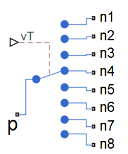SPMT Switch
Single-pole multiple-throw switch
Libraries:
Simscape /
Electrical /
Switches & Breakers
Description
The SPMT Switch block models a single-pole multiple-throw switch. You can specify three to eight throw connections by setting the Number of throw ports parameter to the desired amount. If you only need one or two throw ports, see the SPST Switch and SPDT Switch blocks.
The switch control port physical signal, vT, specifies which throw port connects to the pole:
When vT is in the
[-inf, 1.5]range, the pole always connects to throw port 1, n1.When vT is between one and the number of throw ports, the signal value is rounded to the nearest integer. The pole then connects to the throw port that corresponds to the integer value.
When vT is higher than the number of throw ports, the pole always connects to the last throw port.
Open connections are modeled by a resistor with a value equal to the reciprocal of the Open conductance parameter value. Closed connections are modeled by a resistor with a value equal to the Closed resistance parameter value.
Faults
To model a fault in the SPMT Switch block, in the Faults section, click Add fault next to the fault that you want to model. For more information about fault modeling, see Fault Behavior Modeling and Fault Triggering.
Assumptions and Limitations
The values of the open conductance and closed resistance are the same for all throw ports.
Switch dynamics and custom thresholds are not modeled.
Ports
Refer to the figure for port locations.

Input
Conserving
Parameters
Extended Capabilities
Version History
Introduced in R2020a
